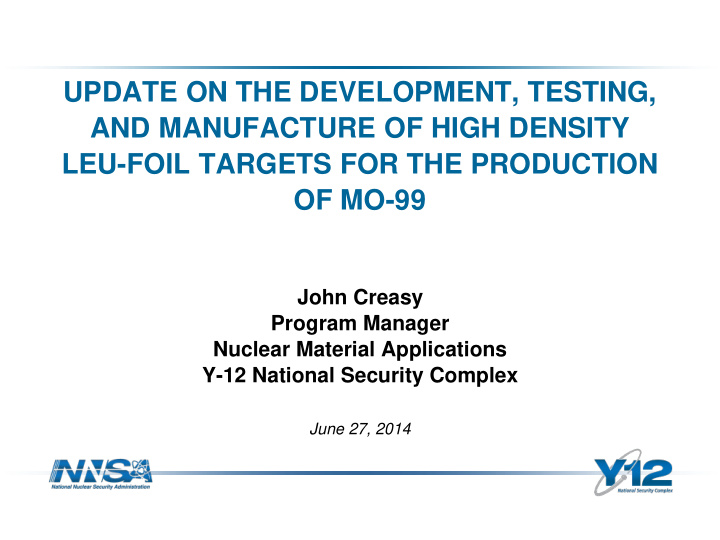



UPDATE ON THE DEVELOPMENT, TESTING, AND MANUFACTURE OF HIGH DENSITY LEU-FOIL TARGETS FOR THE PRODUCTION OF MO-99 John Creasy Program Manager Nuclear Material Applications Y-12 National Security Complex June 27, 2014
LEU-Foil Target Development & Testing Project Objectives : This project is funded by the Convert Pillar of the NNSA Office of Global Threat Reduction, and has the objective to reduce and/or eliminate the use of HEU in commerce. Develop a target testing methodology that is bounding for all Mo-99 target irradiators Develop target testing methodology by building upon the annular target design work and testing previously performed by ANL and ANSTO/CERCA (circa 2004) Expand upon ANSTO’s “safety case” document set of analyses Establish max. target LEU-foil mass Develop a LEU-foil target qualification document Develop a bounding target failure analysis methodology (failure in reactor containment) Optimize Safety vs. Economics Goal is to manufacture a safe, but relatively inexpensive target to offset the inherent economic disadvantage of using LEU in place of HEU Develop target material specifications and manufacturing QC test criteria
LEU-Foil Target Manufacturing, Irradiation & Processing Coolant Target Assembly Component Specifications Target Transport Target Irradiation 150 – 200 h LEU-Foil Target Disassembly Incoming Component Irradiation Rig and Pool Decay ≤ 12 h Inspections Reactor Loading Target Life Cycle Target Life Cycle Target Life Cycle
Historical Work in this Area • Targets of this type have been irradiated by ANSTO, PT BATAN, CNEA, and MURR. • Original design and irradiations were led by ANL team. • The target team was refocused in 2012 to complete target analysis and irradiations domestically (HFIR and MURR)
Team Structure NNSA HQ ANL ORNL Y-12 -Initial Design -Analysis -Project Management -Chemistry -Acid dissolution -Target Fabrication -Chemical Equipment - Foil irradiation -Electro-chemical dissolution MURR MU -LEU Target Irradiation -Target Analysis -PIE -Equipment
Achievements Since Last Topical • ORNL completed extensive target design approval project to approve Annular and Capsule type targets for insertion into HFIR. MURR graduate students were leveraged to assist and gained valuable experience at ORNL • MURR completed their hot cell experiment design and are currently executing target irradiation and fission gas release measurements • ANL completed accelerator driven Mo-99 target irradiation and subsequent dissolution and isotope recovery • Y-12 completed extensive target quality assurance requirements (NQA-1) for the targets, partnering with ORNL and ANL • MU and MURR completed design and testing of new target assembly and disassemble technology
Current Plan • Y-12, ORNL, MURR -Develop target quality control specifications to NQA-1 standards (January 2013) • Y-12 -Manufacture targets for testing (2013 - 2014) • ANL – Design and Manufacture chemical dissolution equipment (2013) • MURR, Y-12 -Manufacture assembly and disassembly equipment (Spring 2014) • ORNL -Install chemical dissolution equipment (Summer 2013) • MURR -Install disassembly equipment (April 2014) • MURR -Irradiate targets (Summer 2014) • MURR -Perform PIE of targets (Summer 2014) • HDT Team – Perform project closeout TRL assessment and documentation
Foil Rolling • Foil rolling consistently to ~125 microns is a challenge that has been solved • Effort was aimed towards lowering scrap rates and increasing consistency.
Target Assembly 1 2 3 Al 6061-T6 Tubes Stainless Steel 304 Surrogate Foil Nickel fission-barrier foil 5 6 4 9 7 8 Good weld vs. Poor weld 12 10 11
Forming Methods • Plug – Widely accepted – “Side - effect” process – Analysis still in process – Contact Issues • Hydroforming – “Direct” process – Promising preliminary results – Contact Issues
Assembly Process Developed Plug-based Assembly System for Annular Targets • The new Hydraulically-driven Drawing Press meets the objectives of sustaining required productivity with the needed quality. • The new design allows for quick loading and unloading of the target and with capability to monitor quality of the assembled targets on-line.
MURR Facility Previous target disassembly experience in a hot cell Four types of targets will be irradiated • Ni wrapped • Al wrapped Hot cell in which experiments will be performed • Ni plated • Al PVD coated
MU Target Disassembly Device and Fission Gas Measurement • MU and MURR designed a semi- automated target disassembly device and completed extensive testing • In addition, this device was placed in a special housing to collect released fission gases to address previous concerns about total fission gas release during disassembly.
Test Locations MU Research Reactor REDC at ORNL HFIR Test Locations MU Disassembly Device
Ni capsules to test Nitric Acid Dissolver • To expedite the recovery of Mo-99 for the nitric acid test, a nickel capsule design was leveraged to allow for use of a pneumatic system in HFIR
THE ARGONNE HDT FRONTEND PROCESSES ACID ELECTROCHEMICAL PROCESS PROCESS 16
Conclusions • The High Density Target project has demonstrated: – ~50 targets irradiated through domestic and international partners (ANL, MURR) – Proof of concept for two front end processing methods (ANL) – Fabrication of uranium foils for target manufacture (Y-12) – Quality control procedures and steps for manufacture (Y-12,MU,ORNL) – Multiple target assembly techniques (MU,Y-12) – Multiple target disassembly devices (MU, ANL, Y-12) – Welding of targets (Y-12,MU) – Thermal, hydraulic, and mechanical modeling (MU) – Robust target assembly parametric studies (MU) – Target qualification analysis for insertion into very high flux environment (ORNL) 17
Conclusions • The High Density Target project has tested and proven several technologies that will benefit current and future Mo-99 producers. • The interlab and university team worked dynamically to share the load of designing, documenting, fabricating, and testing the targets and associated technologies. • This project is set to close out current activities this fiscal year and provide the data obtained and lessons learned freely to our international partners
Recommend
More recommend